Log in or create new account to save this product to your wishlist.
How Much Grass Seed Do I Need?
Calculating how much grass seed you need is simple, but you might need a little reminder of that schoolroom trigonometry. At last, a practical use for trig!
Latest articles
7 MIN 22 Jul How to keep your lawn in shape this summer 9 MIN 15 Jul Watering Your Garden: 10 Top Tips! 11 MIN 15 Jul Is Your Grass Type Right for your Garden? 11 MIN 10 Sep Create Your Low-Maintenance Garden – Tips and Ideas 11 MIN 08 Sep The Ultimate Guide to Choosing the Perfect Hedges for Your Garden 12 MIN 30 Aug The Top 20 Evergreen Climbers to Transform Your GardenWe’re going back to school a little for this week’s article, where we explore the frequently asked question: How much grass seed do I need?
But don’t let the spectre of large, echoey municipal corridors, wedgies, and the memory of fascistic prefects put you off. There’s no over stewed cabbage or stodgy puddings in the MOOWY school of calculations.
Working how much grass seed you need to either sow or overseed an existing lawn is a case of simple maths you learned at school. Hallelujah – for trigonometry finally has an application in real life.
In this article, we’ll show you how to calculate exactly how much grass seed you’ll need to start a new lawn from scratch or overseed for a perfect result every time.
Ready?
Exercise books open; pens at the ready. No talking at the back.
Does it matter how much lawn seed I use?
Well, this would certainly be a short article if it didn’t matter, of course.
First and foremost, it’s essential to understand the mathematical area of your lawn in terms of square metres.
That’s pretty easy with a square or rectangular lawn. But what happens if you have a circular or triangular lawn? Or even worse: an irregularly shaped lawn?
Don’t panic, because we’re going to explain how to work out the area of every lawn. And then, we’ll show you how to work out how much grass seed you need for perfect coverage.
But in answer to the question “does it matter how much lawn seed I use”:
- if you use too little seed, the results will be patchy and inconsistent
- if you use too much seed, it’s a waste because there’s only so many grass plants your soil can support
How much grass seed do I need for a rectangular lawn?
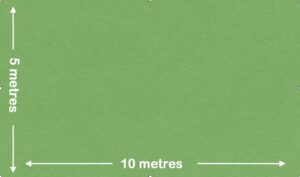
First, calculate the area
Working out the area of a rectangular lawn is the easiest to calculate. We use the same mathematical equation that most of us use when working out how much paint to buy to cover a wall.
All you need to do is:
- Multiply the Length (L) by the Width (W)
- The equation, therefore, is L x M
Our perfectly rectangular lawn above is 10m long (L) and 5m wide (W).
So that’s:
10 x 5
-
Does it matter how much lawn seed I use? -
How much grass seed do I need for a rectangular lawn? -
How do I convert area into rate of application? -
Let’s calculate how much grass seed you need -
How much grass seed do I need for a circular lawn? -
Trigonometry! It’s time for Pi! -
How to calculate the area of a circular lawn -
How much grass seed do I need for a triangular lawn? -
Calculating how much grass seed for an irregularly-shaped lawn
or
10 (L) x 5 (W)
Therefore, 10m x 5m = 50m² / 550ft² – that’s 50 square metres.
How do I convert area into rate of application?
This depends on whether you’re sowing a new lawn from scratch or overseeding an existing lawn. If you’re not sure, check out our article, The Ultimate Guide to Sowing Grass Seed.
The standard recommended application rates are:
- 35g per square metre for sowing a new lawn
- 25g per square metre for overseeding
Let’s calculate how much grass seed you need
We have all of the figures we need. Our lawn is 50m² / 550ft², and we know how much seed to use per square metre.
So, for sowing from scratch, your calculations will be:
50m (area) x 35g (rate of application)
On this occasion, it doesn’t matter that the units are different (i.e., metres x grams). We just multiply the figures, and the answer gives us the number of grams we need to sow from scratch.
So, 50 x 35 = 1750g (or 1.75kg).
If you’re overseeding, your calculations will be:
50m (area) x 25g (rate of application)
Therefore: 50 x 25 = 1250g (or 1.25kg).
And that’s it.
Once you know HOW MUCH seed you’ll need, you might need to know HOW TO sow or overseed grass seed. Check this article for the answer!
How much grass seed do I need for a circular lawn?
The principal is the same as before: square metres x application rate.
The application rate of:
- 35g for sowing
- 25g for overseeding
will always remain the same regardless of the shape of the lawn.
But this is where we need to revise our rudimentary grasp of trigonometry.
Trigonometry! It’s time for Pi!
Remember Pi? No, not the meat and potato variety: Π
Pi is that elusive number with no end – at least, that’s what we were taught in school. We were told that Pi had an infinite number of decimal places, making it quite hard to use in a mathematical equation.

But in March 2019, there was a “Pi Day Miracle” – one of Google’s employees, Emma Haruka Iwao, discovered (don’t ask me how!) that Pi has:
31,415, 926, 535,897 decimal places. We can round that down to 31.4 trillion decimal places.
If you’re super-keen to discover HOW Emma Haruka Iwao worked that out, check out this fascinating article.
Otherwise, let’s move on.
Let’s just call Π (for the ease of calculations) 3.14
How to calculate the area of a circular lawn
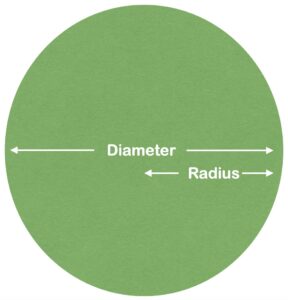
To calculate the area of a circle, you need to know the Radius (R).
Remember: the Radius (the distance from the centre of the circle to the edge) is exactly half the length of the diameter (the distance across the circle, cutting through the centre).
The formula is:
R x R x Π
Or
R² Π
Let’s say our circular lawn is 5 metres wide across the centre.
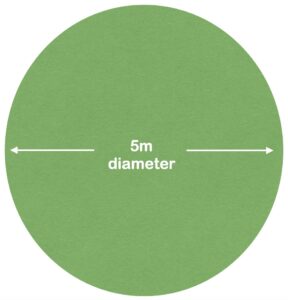
To work out the Radius, we need to halve the Diameter (D). In this case:
5m (D) ÷ 2 = 2.5m
Or
½ x 5 = 2.5
So, our Radius is 2.5m.
To calculate the area of the circle, we need to “square” the Radius (or multiply it by itself) and then multiply that by Pi.
2.5m² (or 2.5 x 2.5) x 3.14 (Pi)
So,
2.5m² x 3.14 = 19.625
That means that the area of our circular lawn is 19.625m². We can round that up to 19.63m², or even 20m² if it’s easier.
For ease of calculation, let’s round it up to 20m².
Multiply your area by the rate of application
The application rate is always going to be the same: 35g for sowing, 25g for overseeding.
So, if our circular lawn is 20m²:
- For sowing, it’s 20 x 35 = 700g
- For overseeding, it’s 20 x 25 = 500g
Simple.
How much grass seed do I need for a triangular lawn?
The area of a triangular lawn is actually really simple to calculate because a triangle is always half of a square (or a rectangle).
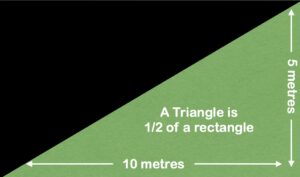
In this case, we don’t need to measure the long edge of the triangle (the hypotenuse) because we have the measurements for the length (L) and width (W).
Use precisely the same formula for calculating the area of a square (L x W), but then divide the answer by 2.
Ie, 10 x 5 = 50m² / 550ft²
÷ 2 = 25m²
Again, use the same application rate calculations to work out how much grass seed to use.
Calculating how much grass seed for an irregularly-shaped lawn
If your lawn is irregular in shape, it’s a little harder to work out the area. But there are some ways that you can estimate it.
It’s always better to overestimate than underestimate. All MOOWY grass seeds come in a resealable, air-tight bag, which helps prolong the lifespan of the seed. So, if you do buy too much, just keep the remainder sealed and use it for overseeding next year.
There are two main methods of calculating the area of an irregular lawn. The first is less accurate (but easier), while the second is more accurate but requires a little more work.
Guestimate the size of your lawn
Regardless of the shape of the lawn, most lawns kind of fit into a square.
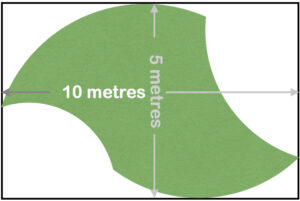
Calculate the length and width of the lawn in the same way as you would for a standard square, using the L x W formula.
Then you’ll need to estimate how much of that square is lawn – perhaps, in this case, it’s around 75%. Remember, it’s better to err on the side of caution, so add an extra 5% for safety.
Once you’ve estimated the area, apply the same rate of application rates according to your needs.
Draw a more accurate plan
The second approach to calculating the area of an irregular lawn is to draw a more accurate plan using graph paper.
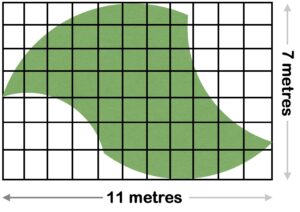
In this garden, the lawn is 11 metres long at its longest and 7 metres wide. Each square represents a square meter, so draw your lawn shape to scale onto the graph paper.
Count how many squares are fully covered by lawn. Then estimate how many cover half of the square. Don’t worry about being too precise here.
We calculate around 26 total squares and 30 partial squares here. So, we could halve the square footage of each partial square, bringing us to 15 sq m.
Therefore, 26 + 15 = 41m²
Again, use the rate of application according to your needs to calculate how much grass seed you need.
Ready to get sowing?
Hopefully, you’ve got everything you need to calculate how much grass seed you’ll need for your seeding project. But we’re always happy to help.
If you need any assistance, just get in touch.
We’re looking forward to hearing from you.
Leave a comment
Your answer will be displayed on the site and the interested party will be notified by email.
Leave a comment
Have a question or want to share your experience? Leave us a comment.
Read more
The best tips and tricks for a lush green lawn
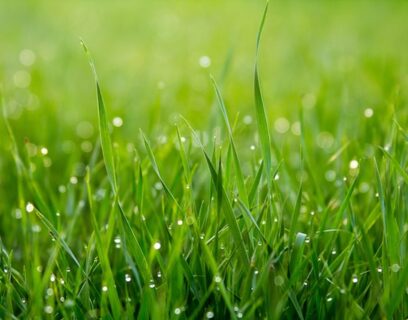 7 MIN
02 Jun
The Great Grass Seed Comparison!
7 MIN
02 Jun
The Great Grass Seed Comparison!
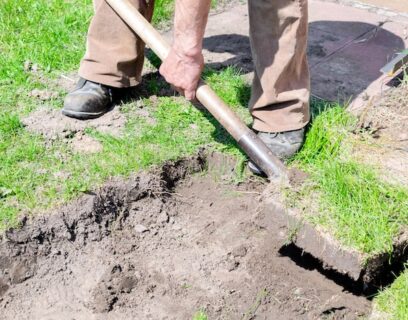 6 MIN
05 Mar
Removing Old Turf: why, when, and how?
6 MIN
05 Mar
Removing Old Turf: why, when, and how?
 Scarifying Kit
All products after scarifying | Quickly restores the lawn after scarifying | Outsmart weeds quickly with the use of this kit
From: € 39.99
Scarifying Kit
All products after scarifying | Quickly restores the lawn after scarifying | Outsmart weeds quickly with the use of this kit
From: € 39.99
 Spring Lawn Care Kit
MOOWY’s choice for the spring | Quick recovery of your lawn after winter | A strong lawn prevents weeds
From: € 25.99
Spring Lawn Care Kit
MOOWY’s choice for the spring | Quick recovery of your lawn after winter | A strong lawn prevents weeds
From: € 25.99
 Long Lasting Lawn Fertiliser
Effective for 90 days | See results in 14 days! | Suitable for all types of grass and soil
From: € 13.99
Long Lasting Lawn Fertiliser
Effective for 90 days | See results in 14 days! | Suitable for all types of grass and soil
From: € 13.99
Do you want a lawn calendar?
🌱 All important maintenance moments for your lawn during the year. Leave your email and we will send you the lawn calendar for free.
Enter your email
Receive the lawn calendar in the mail
Enjoy a green lawn all year round!




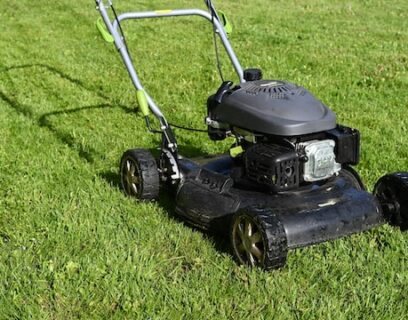





Comments (0)
There are no comments yet. Well then, what are you waiting for to
Be the first to write your comment!inaugurate this pretty page?
Do you have some comments?